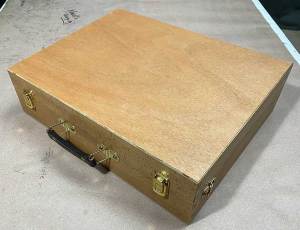
Storing around 5000 sleeved cards that you want to be able to easily get at and play with is a bigger problem than I thought it would be. I found some people using the medium size expansion boxes and some cutting and gluing to make some really cool cases, but I don’t want to cut up my boxes. I found a 3d-printed storage solution, but it added a lot of weight to the original box and didn’t come close to holding all of the cards.
Then I found out Broken Token makes inserts for “All Media Artist’s Supply Sketch Box” sold by Hobby Lobby and I already really like Broken Token inserts. With a couple of online coupons, I got 2 cases for half-off and bought the inserts which all arrived in a week or so.
The art cases are well made, the handle is strong, the hinges keep the lid from flopping open, and the locks are sufficient. The insert fits very tightly, even requiring a little bit of sanding, and even without gluing it into the case I don’t feel like it would slide out unintentionally.
I chose to stain both the cases and inserts with a Cherry colored Min-Wax stain, it took two coats to get the color I wanted, actually they are still a little pinker than I would like, but I think they look a lot better than the natural wood they were originally.
Each case weighs around 25 pounds with both the original version and Villains along with all of the expansions up to New Mutants. Pretty soon I will be buying a third case to hold the coming 2020 and 2021 expansions that Upper Deck has planned.



